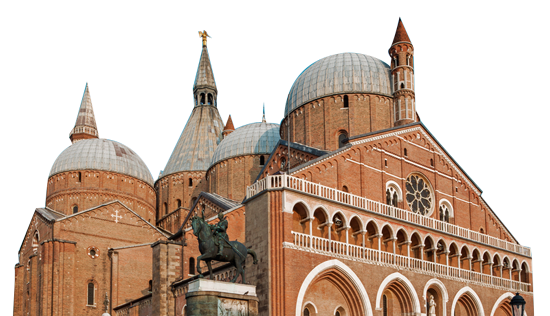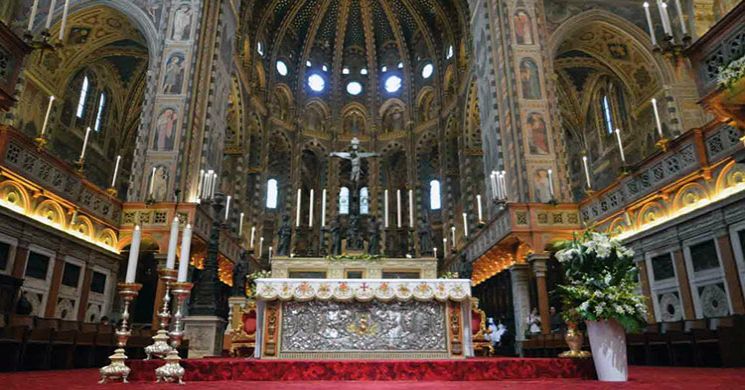The main altar and the presbytery are separated by an elegant communion rail adorned with four beautiful bronze statues by Tiziano Aspetti (1594). This solemn environment is dominated by Donatello’s bronze masterpieces (1448 and after), which together constitute the most famous works of art in the Basilica. The current distribution of the thirty sculptures above and around the altar is the work of Camillo Boito (1895). Dominating everything is Donatello’s Crucifix (1446), in which the divine beauty of Christ is made hu man by the serene acceptance of suffering and death.
Below the Crucifix, in the act of rising from the throne to present the Baby Jesus for the adoration of the faithful, is a maternal and regal portrayal of Our Lady. Beside this there are six statues: the Saints Francis, Justina, and Louis of Anjou on the left of the viewer, and Anthony, Daniel, and Prosdocimus, the first bish op of Padua, on the right. Other marvellous bas-relief bronzes represent the miracles of Saint Anthony, the symbols of the Evangelists, and angels singing and playing musical in struments; at the centre, a dead Christ between two anguished angels. Behind the altar one can admire The Deposition of Christ in the Tomb in Nanto Stone: the artist’s expressionism here reaches its highest levels.
On the left stands a bronze candlestick by Andrea Briosco (also known as ‘Riccio’, 1515): because of its size and artistic merits it is considered to be the most beautiful candelabra in the world. Along the sides of the presbytery there are twelve bronze panels depicting scenes from the Old Testament by B. Bellano (1488) and A. Briosco (1507).
Under the arches of the gates that open on to the presbytery are a number of paintings of Franciscan saints. Worthy of par ticular note is the fresco of St. An thony Giving a Blessing (1326) by a master of the Giotto school. This painting is considered to be the true image of the Saint. Immediately next to this work is the large key board of the double organ: a reminder of the ancient and noble musical traditions of the Basilica.
Behind the altar is the large 18th century choir built according to the design of G. Massari, after a devastating fire had destroyed the previous one, which had been preciously sculptured and inlaid by L. Canozzi from 1462 to 1469. Under the impressive bookcase which contains the choir books, the tomb of Florentine Lorenzo Alberti can still be seen. He died in 1421 and was the father of the more famous Leon Battista. Pause for a moment to admire the pictorial decorations of the sides and of the vaults of the presbytery and the apse: the enormous work of Bolognese artist A. Casanova can be admired, who worked here for some forty years from 1902.


